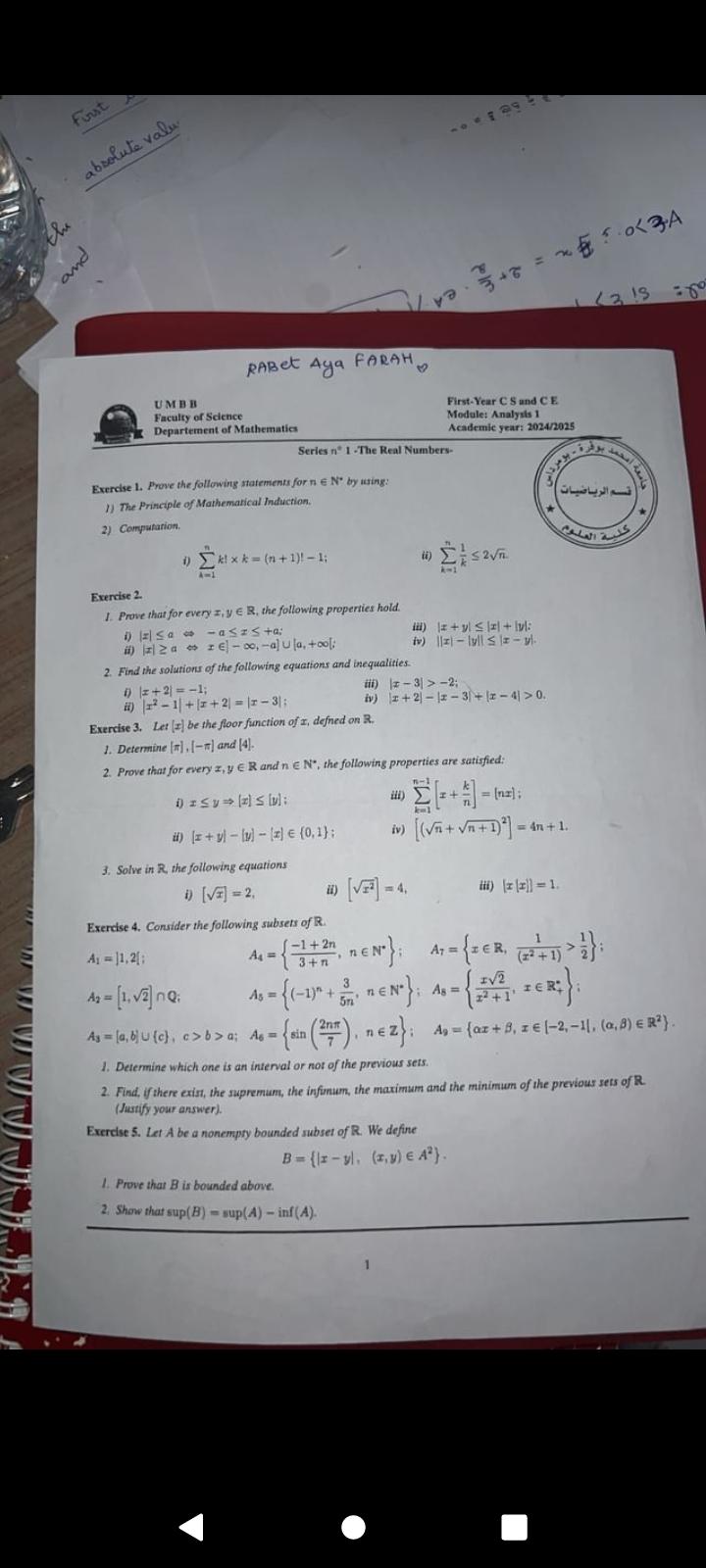Prove the following statements for n in N using: 1) The Principle of Mathematical Induction. 2) Computation. i) Sum from k=1 to n of k equals (n(n+1))/2. ii) Sum from k=1 to n of |... Prove the following statements for n in N using: 1) The Principle of Mathematical Induction. 2) Computation. i) Sum from k=1 to n of k equals (n(n+1))/2. ii) Sum from k=1 to n of |k| is less than or equal to 2√n. Given various properties related to real numbers. Solve the equations involving square roots and floor functions.

Understand the Problem
The question is asking to solve various mathematical exercises related to properties of real numbers, including induction, inequalities, and properties of sets. It covers topics like floor functions, bounded sets, and suprema/inferior calculations.
Answer
Exercises consist of proofs and verification of properties related to real numbers, requiring both theoretical understanding and practical applications.
Answer for screen readers
Answers to each exercise will vary based on their completion. For the first exercise:
- i) ( \sum_{k=1}^{n} k = \frac{n(n + 1)}{2} ) is true. ii) ( \sum_{k=1}^{n} k^2 \leq 2\sqrt{n} ) needs further inequality proof.
Steps to Solve
-
Understanding the Tasks The problem consists of several exercises focusing on properties of real numbers, mathematical induction, inequalities, and sets. We need to address each exercise separately.
-
Exercise 1: Mathematical Induction
-
i) Prove that ( \sum_{k=1}^{n} k = \frac{n(n + 1)}{2} ) by induction.
- Base case: For ( n = 1 ), ( LHS = 1 ) and ( RHS = \frac{1(1 + 1)}{2} = 1 ).
- Inductive step: Assume true for ( n ) (i.e., it holds), then for ( n + 1 ), $$ \sum_{k=1}^{n+1} k = \sum_{k=1}^{n} k + (n + 1) = \frac{n(n + 1)}{2} + (n + 1) = \frac{(n + 1)(n + 2)}{2} $$
- ii) Prove that ( \sum_{k=1}^{n} k^2 \leq 2\sqrt{n} ). Use inequalities and properties of squares.
-
i) Prove that ( \sum_{k=1}^{n} k = \frac{n(n + 1)}{2} ) by induction.
-
Exercise 2: Properties of Real Numbers
- i) Prove for any ( x, y \in \mathbb{R} ): ( |x| \leq a ) implies ( -a \leq x \leq a ).
- ii) Find solutions to equations ( |x - 2| = 3 ).
-
Exercise 3: Floor Function
- Determine ( \lfloor x \rfloor ) for ( x = [n] ), where ( n ) is an integer.
- Prove properties involving ( x ) and floor functions.
-
Exercise 4: Analyzing Subsets of ( \mathbb{R} )
- Identify which given sets ( A_1, A_2, \ldots, A_7 ) are intervals.
- Calculate suprema and infima for the sets, justifying your reasoning.
-
Exercise 5: Bounded Sets
- 1) Prove the set ( B ) is bounded above.
- 2) Prove that ( \sup(B) = \sup(A) - \inf(A) ) using properties of suprema and infima.
Answers to each exercise will vary based on their completion. For the first exercise:
- i) ( \sum_{k=1}^{n} k = \frac{n(n + 1)}{2} ) is true. ii) ( \sum_{k=1}^{n} k^2 \leq 2\sqrt{n} ) needs further inequality proof.
More Information
The exercises cover various foundational concepts in real analysis, including the principles of mathematical induction, properties of absolute values, and characteristics of bounded sets. Understanding these concepts is crucial for higher-level mathematics.
Tips
- Induction Base Case: Often, the base case can be overlooked or incorrectly calculated.
- Handling Inequalities: Make sure to apply properties of inequalities correctly to avoid sign errors.
AI-generated content may contain errors. Please verify critical information